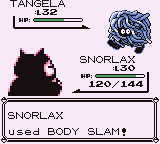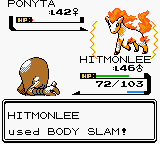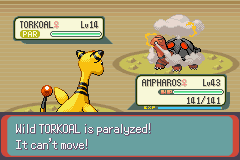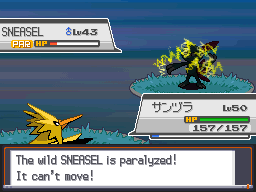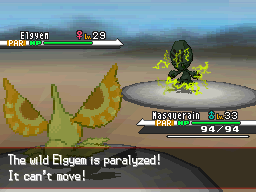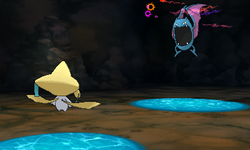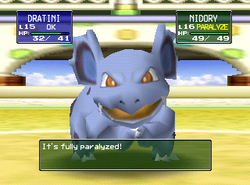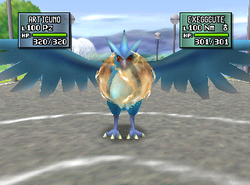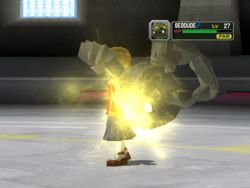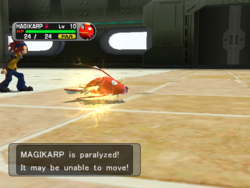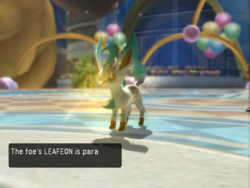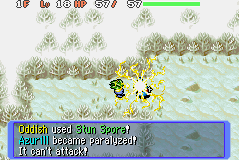Paralysis (status condition): Difference between revisions
No edit summary |
mNo edit summary |
||
| Line 1: | Line 1: | ||
{{incomplete|needs=Gen IV and V effect, Non-game info}} | {{incomplete|needs=Gen IV and V effect, Non-game info}} | ||
[[File:Ash Pikachu Static.png|thumb|250px|right|{{AP|Pikachu}} paralyzing {{TP|Paul|Ursaring}}]] | [[File:Ash Pikachu Static.png|thumb|250px|right|{{AP|Pikachu}} paralyzing {{TP|Paul|Ursaring}}]] | ||
The '''paralysis''' condition (PAR) (Japanese: '''まひ''' ''Paralysis''), also called '''paralyze''' in the [[Pokémon Stadium]] | The '''paralysis''' condition (PAR) (Japanese: '''まひ''' ''Paralysis''), also called '''paralyze''' in the [[Pokémon Stadium series]], causes a Pokémon to be unable to attack ("fully paralyzed") a quarter of the time. Additionally, its {{stat|Speed}} is reduced to 50% of its previous value (25% prior to [[Generation VII]]). Many moves that cause paralysis are {{type|Electric}}. {{type|Ground}} Pokémon can be paralyzed, but not by Electric-type moves or by the [[Battle Arcade]]. In Generation V, Pokémon glow yellow when afflicted with paralysis. | ||
==Effect== | ==Effect== | ||
Revision as of 11:07, 5 February 2017

|
This article is incomplete. Please feel free to edit this article to add missing information and complete it. Reason: Gen IV and V effect, Non-game info |
The paralysis condition (PAR) (Japanese: まひ Paralysis), also called paralyze in the Pokémon Stadium series, causes a Pokémon to be unable to attack ("fully paralyzed") a quarter of the time. Additionally, its Speed is reduced to 50% of its previous value (25% prior to Generation VII). Many moves that cause paralysis are Electric-type. Ground-type Pokémon can be paralyzed, but not by Electric-type moves or by the Battle Arcade. In Generation V, Pokémon glow yellow when afflicted with paralysis.
Effect
In general, a paralyzed Pokémon runs a 25% risk of losing their turn due to full paralysis. In addition, the afflicted Pokémon's Speed is decreased. The specifics work differently between generations.
Generation I
The Speed of a paralyzed Pokémon is decreased by 75%. Changing the Speed modifier of a paralyzed Pokémon would reset the Speed to act as if the Pokémon were not paralyzed, effectively nullifying the cut stat. Rest, Full Heal, and Paralyz Heal cure the affliction, but do not fix the Speed reduction caused by it. In Pokémon Stadium, both of those errors were fixed. Additionally, the move Haze would cure the user's Speed drop if it was paralyzed until it was next switched in.
Generation II
If a paralyzed Pokémon Baton Passed to another paralyzed Pokémon, the second one would not have its Speed reduced until a move which affected the Speed stat modifier, recalculating its Speed, was used. In Pokémon Stadium 2, however, the new Pokémon's Speed is reduced if the last Speed-modifying attack used was one that raised Speed. It will not be reduced if the new Pokémon uses a Speed-modifying attack.
Generation III and IV
An animation is shown now when a Pokémon is fully paralyzed (in contrast to previous generations, where there was only an animation when paralysis was inflicted). The text is also different when fully paralyzed. Instead of saying "X is fully paralyzed" it will say "X is paralyzed! It can't move!"
Generation V
Pokémon now glow yellow and their animation slows down when inflicted with paralysis.
Generation VI
Electric-type Pokémon are now immune to paralysis.
Generation VII
The Speed of a paralyzed Pokémon is decreased by 50% (as opposed to 75%).
Appearance
Causes
Moves
A Pokémon can be paralyzed when struck by any of the following moves.
|
Other causes
A Pokémon has a 30% chance of being paralyzed after making contact with a Pokémon with the Static Ability. In addition, Effect Spore has a 30% chance of causing either paralysis, sleep, or poison. A Pokémon can also become paralyzed if it directly paralyzes a Pokémon with the Synchronize ability.
Curing
Paralysis can be cured with the use of a Parlyz Heal or a Cheri Berry (PRZCureBerry in Generation II). In addition, like all other major status conditions, it can be cured by the items Full Heal, Rage Candy Bar, Lava Cookie, Old Gateau, Casteliacone, Lumiose Galette, Shalour Sable, Big Malasada, Full Restore, Heal Powder, Lum Berry (Miracle Berry in Generation II), and Sacred Ash.
The moves Refresh and Rest remove the paralysis from the user, while Heal Bell (unless the Pokémon has Soundproof as their Ability in Generation III and IV) and Aromatherapy remove it from all Pokémon in the user's party. In addition, the move Psycho Shift shifts the paralysis onto its target (thereby healing the user). Furthermore, if its target is paralyzed, Smelling Salts will cure the paralysis in addition to becoming more powerful. In Generation I only, using Haze cures the opponent from paralysis.
Pokémon with Natural Cure will be cured upon switching out, those with the Hydration Ability will be cured whilst it is raining. Pokémon with Shed Skin have a 30% chance of being cured every turn, and Pokémon with Healer have a 30% chance of curing their allies.
Prevention
Starting in Generation VI, Electric-type Pokémon are immune to being paralyzed. However, if a Pokémon's Electric type is changed through a type-changing move like Soak, it is then paralyzed and switched out (resetting to the Electric type), the paralysis will remain.
Pokémon with the Comatose Ability are completely immune to being paralyzed. Pokémon with the Ability Leaf Guard will be protected from status conditions in harsh sunlight. In Generation IV only, the Ability Magic Guard will prevent Pokémon from being fully paralyzed; however, it does not prevent the Speed reduction.
The moves Safeguard and Misty Terrain (for grounded Pokémon) will protect the party from status conditions for five turns. A Pokémon behind a substitute cannot be paralyzed, except due to Synchronize.
Advantages
While paralysis, like all major status conditions, has primarily negative effects, it can be advantageous to have it in certain conditions. Pokémon with Guts, Marvel Scale, and Quick Feet will have their Attack, Defense, and Speed increased, respectively, when paralyzed, poisoned, or burned. In addition, the base power of Facade is doubled (from 70 to 140) when inflicted with any of these three status conditions.
Other game effects
In Pokémon Emerald, when the player is inside the Battle Pyramid, the types of Pokémon encountered on each floor follow a set of categories; one of these categories is Pokémon with moves that paralyze.
In the spin-off games
Mystery Dungeon series
Paralyzed Pokémon cannot use moves or regular attack, but they can still throw items. Their Movement Speed is reduced by one stage. Paralysis wears off after a few turns.
Rumble series
Paralysis (Paralyzed when inflicted in-game) is a negative status in the Rumble series. A Pokémon affected by paralysis is unable to move or use any moves for roughly five seconds. However, if the affected Pokémon is controlled by a player, inputting movement or button commands will make the effect wear off faster, with a minimum duration of about two seconds. Paralyzed Pokémon shake in place with their body surrounded by yellow lightning-bolt-shaped particles.
No types are immune to paralysis, but Pokémon with the Adept, Electric Boost, or Steady Special Traits cannot be paralyzed, and those with the Reflector Trait will cause the user of the paralysis-inflicting move to become paralyzed instead if hit by one.
Pokémon Conquest
As in the main series, in Pokémon Conquest, paralysis lowers the Pokémon's Speed, and there is a chance at the start of each turn for the Pokémon to be fully paralyzed and unable to act, though their Warrior may still use items and abilities. Because Pokémon Conquest uses Speed to determine the accuracy of attacks, Pokémon inflicted with paralysis also suffer a heavy penalty to their accuracy and evasion. Paralysis can be inflicted by abilities, attacks, and Electro Nodes in Dragnor. It can be cured with Warrior Skills, items, or ending the Pokémon's turn in a hot spring, water bucket, or next to one of Dragnor's Revival Nodes.
Pokémon Shuffle
In Pokémon Shuffle, a paralyzed Pokémon cannot use any disruptions and its disruption countdown is paused.
Paralysis can be inflicted by Pokémon with the Paralyze, Shock Attack, or Quake Skills. The Paralysis Combo Skill also boosts damage against paralyzed foes.
Flying, Poison, Ghost, Steel, Electric, Psychic, Dragon, and Fairy-type Pokémon are immune to paralysis.
In the anime

- In Haunter versus Kadabra, Haunter accidentally paralyzed Misty by licking her.
- In Poké Ball Peril, Professor Ivy had been paralyzed when she attempted to save a Raticate who wandered too close to a group of Vileplume who were releasing Stun Spore.
- In The Stun Spore Detour, Ash and Tracey both became paralyzed after inhaling Vileplume Stun Spore. Misty set out alone to find Salveyo weed to cure them. Jessie also suffered a similar fate which forced James and Meowth to find Salveyo weed themselves. They ultimately made a plan to steal the Salveyo weed that Misty had collected. Because she felt bad and knew that they were trying to help Jessie, she gave some of her Salveyo weed to them. The weed was boiled into tea and Ash, Tracey, and Jessie fully recovered.
- In Better Eight Than Never, Ash's Snorlax was paralyzed by Clair's Gyarados's Dragon Breath.
- In Tie One On!, Jackson's Magneton managed to paralyze Ash's Pikachu and Cyndaquil with Thunder Wave.
- In Balance of Power, Ash's Pikachu managed to use his Static to paralyze Norman's Vigoroth.
- In Cruisin' for a Losin', Savannah's Lairon managed to paralyze May's Bulbasaur with Shock Wave, despite the move not usually being able to paralyze its target. This was explained to be because of Bulbasaur being in direct contact with Lairon via her Vine Whip.
- In Queen of the Serpentine!, Ash's Pikachu managed to paralyze Lucy's Milotic with Volt Tackle. This, however, allowed Milotic to counterattack with a powered-up Facade.
- In Overjoyed!, Ash's Torkoal was paralyzed after taking a hit from Brandon's Registeel's Zap Cannon.
- In Pace - The Final Frontier!, Ash's Pikachu's Thunderbolt caused Brandon's Regice to get paralyzed twice. It was, however, able to overcome both the paralysis and the damage taken by using Rest on both occasions.
- In Shapes of Things to Come!, Paul's Elekid managed to paralyze Roark's Onix with its Static when Onix used Slam on it.
- In A Triple Fighting Chance!, Ash's Chimchar and Buizel were paralyzed by Maylene's Lucario's Force Palm.
- In A Pyramiding Rage!, Paul's Ursaring was paralyzed when it was hit by Brandon's Regice's Zap Cannon.
- In Evolving Strategies!, Paul's Ursaring was paralyzed by Ash's Pikachu Static. This time however, its Guts Ability activated, allowing it to swiftly defeat Pikachu. In the same episode, Ash's Monferno was also paralyzed by Paul's Electabuzz's Thunder. However, it managed to overcome the paralysis with sheer determination.
- In The Eighth Wonder of the Sinnoh World!, Ash's Pikachu's Static paralyzed Volkner's Electivire via the contact made by Electivire's Ice Punch.
- In Scraggy-Hatched to be Wild!, Ash's Scraggy became paralyzed after being attacked by a wild Galvantula. Iris and her Axew retrieved an herb which she then crushed into a medicine to cure his status condition.
- In The Club Battle Hearts of Fury: Emolga Versus Sawk!, Stephan's Sawk was paralyzed by Iris's Emolga's Static after using Close Combat on her, leading to his defeat.
- In Rocking the Virbank Gym! Part 2, Roxie's Garbodor was paralyzed by Ash's Pikachu's Static after it had used Double Slap on him, leading to its defeat.
- In New Places... Familiar Faces!, Iris's Emolga and Cilan's Stunfisk were paralyzed by James's Amoonguss's Stun Spore.
- In The Name's N!, Pikachu fell victim for James's Amoonguss's Stun Spore as well. Pikachu was healed when N had two wild Alomomola use Refresh on him. N also gave Pikachu an Oran Berry so he could regain his lost health.
- In Danger, Sweet as Honey!, Meowth was paralyzed when he was accidentally hit by a wild Victreebel's Stun Spore. He was cured back to health by Pikachu, Axew, and Oshawott.
- In Searching for a Wish!, both Pikachu and Axew were paralyzed by James's Amoonguss's Stun Spore. They were healed after a wild Jirachi used Healing Wish.
- In A Shockingly Cheeky Friendship!, James's Inkay was paralyzed when Dedenne used Nuzzle on it, leading to its defeat. Bonnie, not realizing that Nuzzle is an attack, was also briefly paralyzed when she rubbed cheeks with Dedenne.
- In To Catch a Pokémon Smuggler!, Dolan's Diggersby was paralyzed when a newly evolved Vivillon Dolan was trying to steal used Stun Spore on it, leading to its defeat.
- In A Fork in the Road! A Parting of the Ways!, Jessie and her Wobbuffet were paralyzed by a wild Gloom's Stun Spore. They were both cured when Dr. White gave them a Cheri Berry.
- In The Moment of Lumiose Truth!, Ash's Goodra was paralyzed by Clemont's Heliolisk's Thunder Wave during Ash's Gym battle with Clemont. Goodra was later healed when its Hydration Ability was activated thanks to its own Rain Dance.
- In All Eyes on the Future!, Ash's Frogadier was paralyzed by Olympia's Meowstic's Thunder Wave (although the move was aimed at Talonflame) during Ash's Anistar Gym battle, causing Frogadier to get immobilized several times during the match.
- In Finals Not for the Faint-Hearted!, Ash's Hawlucha was paralyzed when it was hit by Alain's Bisharp's Thunder Wave.
Trivia
- Paralysis can be inflicted by moves of ten different types, more than any other non-volatile status condition.
In other languages
|
Paralysis
|
Paralyzed
| |||||||||||||||||||||||||||||||||||||||||||||||||
| Status conditions | |||
|---|---|---|---|
| BURN | FREEZE | PARALYSIS | POISON |
| SLEEP | CONFUSION | FLINCH | FAINTING |

|
This game mechanic article is part of Project Games, a Bulbapedia project that aims to write comprehensive articles on the Pokémon games. |

